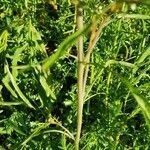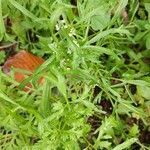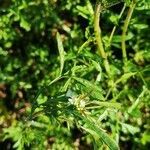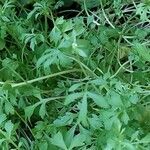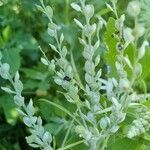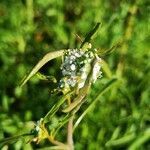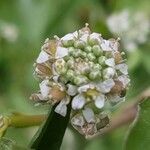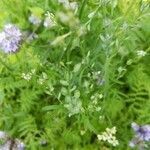Herbs annual, (10-)20-80(-100) cm tall. Stems erect, simple or branched, sparsely crisped pilose above. Basal leaves not rosulate; petiole 1-4 cm; leaf blade variable in shape, 1-or 2-pinnatifid or-pinnatisect, 2-8(-10) × 1-3(-5) cm; ultimate lobes ovate or oblong, margin dentate, apex acute. Cauline leaves petiolate; leaf blade similar to basal ones but less divided, with 1-4 lateral lobes on each side of midvein; uppermost leaves subsessile, linear, margin entire. Fruiting pedicels suberect, appressed to rachis, or ascending, straight, 1.5-4(-6) mm, terete or slightly flattened, glabrous. Sepals oblong, 1-1.8 × 0.5-0.8 mm, glabrous or pubescent abaxially. Petals white or lavender, spatulate or obovate, 2.5-3.5(-4) × 0.7-1.4 mm, base attenuate. Stamens 6; filaments 1.5-2 mm; anthers oblong, 0.4-0.5 mm. Fruit oblong-ovate or elliptic, (4-)5-6(-7) × 3-4.5(-5.5) mm, base rounded, margin and apex broadly winged, apex emarginate; wings 1-1.5 mm at apex; apical notch 0.2-0.5 mm; style 0.2-0.5(-0.8) mm, free from wings, included in or rarely exserted from apical notch. Seeds reddish brown, oblong, 2-2.6 × 1-1.3 mm, wingless; cotyledons incumbent, 3-lobed. Fl. Jun-Jul, fr. Aug-Sep. 2n = 24, 32*.
Annual herb with fine taproot.. Stem up to 70 cm. high, erect, simple to much branched, glabrous or with very scattered minute hairs.. Leaves petioled, very sparsely pubescent, up to 10 cm. long, pinnati-or bipinnatipartite, with 2–4 pairs of lateral lobes; lobes linear, lanceolate or oblanceolate (in lower leaves even obovate), up to 3 cm. long; uppermost leaves sometimes simple, serrate.. Racemes terminal, with comparatively conspicuous whitish flowers, in fruit lax, up to 25 cm. long; pedicels in fruit 3–6 mm. long, ascending to almost erect, straight, glabrous.. Sepals green with membranous margins, elliptic, 1–1.5 mm. long, with scattered fine hairs.. Petals white or violet, spathulate to slightly clawed, with rounded apex, 1.7–3 mm. long.. Stamens with a single small nectarial gland between each of them.. Ovary elliptic, emarginate, with projecting style.. Siliculae elliptic in outline, 4.5–6.5 mm. long, 3–4 mm. broad, with prominent apical wings, deeply emarginate; style distinct, with stigma completely within or just level with the top of the sinus.. Seed wingless, reddish brown, 2–3 mm. long, ± 1.5 mm. broad.. Fig. 5/1.
Annual herb with slender taproot, up to 70 cm high, erect, simple or much branched, glabrous or with scattered minute hairs. Leaves membranous, petioled, very sparsely pubescent, up to 10 cm long, imparipinnati-or bipinnatipartite, with 2-4 pairs of lateral lobes; lobes linear, lanceolate or oblanceolate, up to 3 cm long; uppermost leaves sometimes simple, serrate. Racemes terminal, with rather conspicuous whitish flowers, in fruit loose, up to 25 cm long; pedicels in fruit 3-6 mm long, ascending to almost erect, straight, glabrous. Sepals green with membranous margins, elliptic, 1-1.5 mm long. Petals white or violet, spathulate to slightly clawed, with rounded apex, 1.7-3 mm long. Stamens 6, with a single small nectary between each of them. Ovary elliptic, emar-ginate, with projecting style. Siliculae elliptic in outline, 4.5-6.6 mm long, 3-4 mm broad, with prominent apical wings, deeply emarginate; style distinct, with stigma completely within or just level with the top of the sinus. Seeds wingless, reddish brown, 2-3 mm long, c. 1.5 mm broad.
Annual. Stem erect, glabrous, (10)-20-40-(90) cm tall. Basal lvs withering at flowering, glabrous or sparsely hairy, 3-10-(20) × 1-4-(8) cm, 1-2-pinnatifid with slender toothed lobes. Middle stem lvs deeply 1-2-pinnatisect with linear-obovate lobes; uppermost lvs sparsely hairy, 1-pinnatifid, becoming linear-obovate, entire, 2-4 × 0.3-0.5 cm. Racemes 10-25 cm long; pedicels 4-6 mm at fruiting. Sepals sparsely hairy, 1-1.5 × 0.4-0.6 mm. Petals twice as long as sepals, white or reddish. Stamens 6. Silicle elliptic, narrowly winged above, 5-6 × 3-5 mm; style not projecting beyond deep apical notch; valves glabrous. Seeds narrowly ovoid, red-brown, not winged, up to 5 mm long; cotyledons deeply 3-lobed.
Annual herb; stems erect, unbranched, 20–40 cm high, glabrous. Basal leaves bi-to tri-pinnatisect; cauline leaves reducing to linear, entire, sessile, sparsely hairy, the hairs acicular. Inflorescence an elongating raceme. Sepals 1–1.5 mm long, sparsely hairy. Petals 2–3 mm long, somewhat clawed, white or reddish. Stamens 6. Style to 0.5 mm long, included. Silicula broadly ovate, 5–6 mm long, 3–5 mm wide, glabrous; wing narrow above, one-fifth length of silicula; pedicels 3–5 mm long, ascending to erect. Seeds ovoid, 2–3 mm long; radicle incumbent; cotyledons trifid.
A cabbage family herb. It is an annual plant about 60 cm high. It has narrowly lobed leaves. The leaves near the base have long stalks and the leaves higher on the plant do not have stalks. The flowers are small and white. The fruit is a pod. These are oval and deeply notched. The seed pods are reddish brown. The plant develops tuberous roots and grow for a second season. There are some named cultivated varieties.
. Glabrous, ± glaucous annual 2–4 dm; lvs pinnately dissected into a few linear, oblong, or oblanceolate segments; fls 2 mm wide; stamens 6; fr elliptic-oval, 5–7 mm, two-thirds as wide, deeply notched; style half as long to nearly as long as the notch; mature pedicels erect or closely ascending, 2–4 mm; 2n=16, 24. Native probably of w. Asia, escaped from cult. especially in the ne. part of our range.
